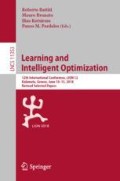Abstract
A risk measure that specifies minimum capital requirements is the amount of cash that must be added to a portfolio to make its risk acceptable to regulators. The 2008 financial crisis highlighted the demise of the most widely used risk measure, Value-at-Risk. Unlike the Conditional VaR model of Rockafellar & Uryasev, VaR ignores the possibility of abnormal returns and is not even a coherent risk measure as defined by Pflug. Both VaR and CVaR portfolio optimizers use asset-price return histories. Our novelty here is introducing an annual Desirability Value (DV) for a company and using the annual differences of DVs in CVaR optimization, instead of simply utilizing annual stock-price returns. The DV of a company is the perpendicular distance from the fundamental position of that company to the best separating hyperplane \(H_0\) that separates profitable companies from losers during training. Thus, we introduce both a novel coherent surrogate risk measure, Conditional-Desirability-Value-at-Risk (CDVaR) and a direction along which to reduce (downside) surrogate risk, the perpendicular to \(H_0\). Since it is a surrogate measure, CDVaR optimization does not produce a cash amount as the risk measure. However, the associated CVaR (or VaR) is trivially computable. Our machine-learning-fundamental-analysis-based CDVaR portfolio optimization results are comparable to those of mainstream price-returns-based CVaR optimizers.
Access this chapter
Tax calculation will be finalised at checkout
Purchases are for personal use only
Notes
- 1.
Our DV is not related to the desirability function of [14].
- 2.
We have both the V(i, j, k) and the E(i, j, k) columns.
- 3.
Using relative returns of DV does produce very similar results.
- 4.
Even though the EWP consists of stocks from BIST 50, we make the comparison to the more popular sister index BIST 100.
- 5.
T is referred to as the portfolio cycle length, which is 10.5 months in our case.
References
Acerbi, C., Tasche, D.: Expected shortfall: a natural coherent alternative to value at risk. Econ. Notes 31(2), 379–388 (2002)
Alpaydin, E.: Introduction to Machine Learning. MIT Press, Cambridge (2004)
Artzner, P.: Coherent measures of risk. Math. Financ. 9, 203–228 (1999)
http://bigpara.hurriyet.com.tr/borsa/gecmis-kapanislar (2018)
Baronyan, S.R., Boduroğlu, I.I., Sener, E.: Investigation of stochastic pairs trading strategies under different volatility regimes. Manch. Sch. 78, 114–134 (2010). https://doi.org/10.1111/j.1467-9957.2010.02204.x
Boduroğlu, I.I., Erenay, Z.: A machine learning model for predicting a financial crisis in Turkey: Turkish economic stability index. Int. J. High Perform. Comput. Appl. 21(1), 5–20 (2007)
Çobandağ-Güloğlu Z., Weber G.W. (2017) Risk Modeling in Optimization Problems via Value at Risk, Conditional Value at Risk, and Its Robustification. In: Pinto A., Zilberman D. (eds) Modeling, Dynamics, Optimization and Bioeconomics II. DGS 2014. Springer Proceedings in Mathematics & Statistics, vol 195. Springer, Cham
Computational Finance, Abu-Mostafa, Y. (Ed.): Computational Finance 1999, 2nd edn. MIT Press, Cambridge (2001)
Elton, E.J., Gruber, M.J., Brown, S.J., Goetzman, W.N.: Modern Portfolio Theory and Investment Analysis, 7th edn. Wiley, New York (2007)
Freitas, F.D., De Souza, A.F., de Almeida, A.R.: Prediction-based portfolio optimization model using neural networks. Neurocomputing 72(10–12), 155–2170 (2009). ISSN 0925–2312, https://doi.org/10.1016/j.neucom.2008.08.019
GAMS Development Corp.: GAMS: The Solver Manuals, GAMS Development Corp. Washington (2017)
Hannoun, H.: The Basel III Capital Framework: a decisive breakthrough. BoJ-BIS High Level Seminar on Financial Regulatory Reform: Implications for Asia and the Pacific. Hong Kong SAR, 22 Nov 2010 (2010)
Harington, J.: The desirability function. Ind. Quality Control 21, 494–498 (1965)
Hosmer, D.W., Lemeshow, S.: Applied Logistic Regression, 2nd edn. Wiley, New York (2000)
Hull, J.: Risk Management and Financial Institutions. Prentice Hall, Upper Saddle River (2006)
Karaçor, A.G., Erkan, T.E.: In: Çelebi N. (ed.) On the Comparison of Quantitative Predictabilities of Dierent Financial Instruments, Chapter in Intelligent Techniques for Data Analysis in Diverse Settings (Advances in Data Mining and Database Management), p. 282 (2016)
Ince, H., Trafalis, T.B.: Kernel methods for short-term portfolio management. Expert Syst. with Appl. 30(3), 535–542 (2006). ISSN 0957–4174, 2006, https://doi.org/10.1016/j.eswa.2005.10.008
International Financial Reporting Standards: www.iasb.org/IFRS+Summaries (2008)
Johnson, T., Maxwell, P.A.R.: Homogeneous Risk Classifications for Industry Studies, Wiley Online Library (2007). https://doi.org/10.1111/j.1475-4932.1976.tb01570.x
Ch, G.: Pflug, Some remarks on the value-at-risk and conditional-value-at-risk. In: Uryasev, S. (ed.) Probabilistic Constrained Optimization, Methodology and Applications. Kluwer (2000)
Press, E.: Analyzing Financial Statements, Lebahar-Friedman (1999)
Rockafellar, R.T., Uryasev, S.: Optimization of conditional value-at-risk. J. Risk (2000)
Rosenthal, R.E.: GAMS: A User’s Guide, GAMS Development Corp. Washington (2017)
Scherer, B., Martin, D.: Intro to Modern Portfolio Optimization with NuOPT and \(S^{+}\) Bayes. Springer (2005)
Trading Economics Web Page (2018). https://tradingeconomics.com/united-states/interest-rate
Vos, E.: Risk, return, price: small unlisted businesses examined. J. SEAANZ 3(1–2), 12–120 (1995)
Ziemba, W.T.: The symmetric downside-risk sharpe ratio. J. Portf. Manag. 32(1), 108–122 (2005)
Acknowledgements
Attila Odabaşı initialized the author’s thoughts on using machine learning techniques in fundamental analysis. Ahmet Boyalı did the initial calculations in the machine learning problem. Murat G. Aktaş, CEO of Finnet Corp., provided us with guidance along with balance sheet data. Selahaddin Yıldırım wrote the Python code that handled the portfolio bookkeeping. The author is also grateful to the organizers of the LION 12 Conference at Kalamata. He also thanks the three anonymous referees, as well as Wolfgang Hörmann and Sevda Akyüz for reading the paper and providing him with ideas for a better presentation.
Author information
Authors and Affiliations
Corresponding author
Editor information
Editors and Affiliations
Rights and permissions
Copyright information
© 2019 Springer Nature Switzerland AG
About this paper
Cite this paper
Boduroğlu, İ.İ. (2019). Portfolio Optimization via a Surrogate Risk Measure: Conditional Desirability Value at Risk (CDVaR). In: Battiti, R., Brunato, M., Kotsireas, I., Pardalos, P. (eds) Learning and Intelligent Optimization. LION 12 2018. Lecture Notes in Computer Science(), vol 11353. Springer, Cham. https://doi.org/10.1007/978-3-030-05348-2_23
Download citation
DOI: https://doi.org/10.1007/978-3-030-05348-2_23
Published:
Publisher Name: Springer, Cham
Print ISBN: 978-3-030-05347-5
Online ISBN: 978-3-030-05348-2
eBook Packages: Computer ScienceComputer Science (R0)

